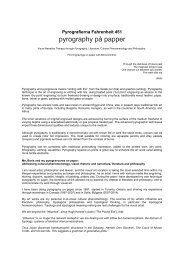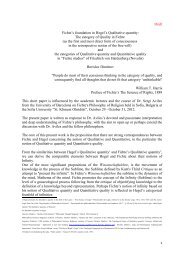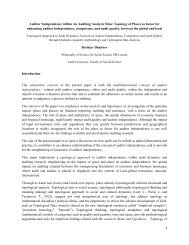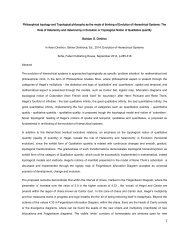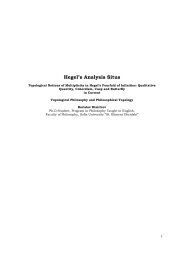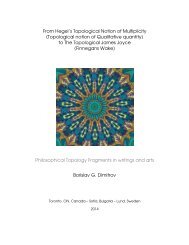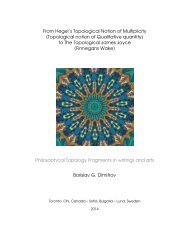Topological Ontology and Logic of Qualitative quantity
Qualitative quantity and BFO (Basic Formal Ontology) of /Barry Smith/ and YAMATO (Yet Another More Advanced Top-level Ontology) of /Riichiro Mizoguchi/
Qualitative quantity and BFO (Basic Formal Ontology) of /Barry Smith/ and YAMATO (Yet Another More Advanced Top-level Ontology) of /Riichiro Mizoguchi/
- No tags were found...
You also want an ePaper? Increase the reach of your titles
YUMPU automatically turns print PDFs into web optimized ePapers that Google loves.
Kairos, Chora <strong>and</strong> Topos as follow: "Chronochora", "Chronotopos", "Kairochora" <strong>and</strong><br />
"Kairotopos".<br />
There are two notions <strong>of</strong> Time <strong>and</strong> two notion <strong>of</strong> Space in the Ancient Greek concepts <strong>of</strong><br />
time <strong>and</strong> space. The two temporal notion <strong>of</strong> Time are Chronos <strong>and</strong> Kairos. Chronos is the<br />
quantitative Time <strong>and</strong> Kairos is the qualitative Time. And there are two spatial notion <strong>of</strong><br />
Space – Chora <strong>and</strong> Topos. Chora is the quantitative abstract notion <strong>of</strong> space <strong>and</strong> Topos is the<br />
qualitative notion <strong>of</strong> space. The abstract space is Chora <strong>and</strong> the concrete place is Topos.<br />
Aristotle defined Chronos quantitatively as the “number <strong>of</strong> motion with respect to the before<br />
<strong>and</strong> the after”, which is a classical expression <strong>of</strong> the concept <strong>of</strong> (chronos) time as change,<br />
measure, <strong>and</strong> serial order. The definition <strong>of</strong> Chronos is focused on an exact quantification <strong>of</strong><br />
time.<br />
Following Aristotele analysis there are temporal <strong>and</strong> spatial pairs <strong>of</strong> chronos/kairos <strong>and</strong><br />
chora/topos, relationships. Kairos is the time that gives value thus quality. Kairos is<br />
qualitatively defined. The result would produce the following:<br />
- quantitative <strong>quantity</strong> - /in the domain <strong>of</strong> Chronochora – Abstract<br />
Space <strong>and</strong> Abstract Time/;<br />
- quantitative quality - /in the domain <strong>of</strong> Chronotopos -Meaningful<br />
Place <strong>and</strong> Abstract Time/;<br />
- qualitative <strong>quantity</strong> - /in the domain <strong>of</strong> Kairochora – Abstract Space<br />
<strong>and</strong> Meaningful Time/;<br />
- qualitative quality - /in the domain <strong>of</strong> Kairotopos – Meaningful Place<br />
<strong>and</strong> Meaningful Time/.<br />
This fourfold <strong>of</strong> infinities (in Hegel) could be expressed by the term or category <strong>of</strong><br />
COBORDISM - A cobordism between a single circle (at the top) <strong>and</strong> a pair <strong>of</strong> disjoint circles<br />
(at the bottom).<br />
In topological terms, the category <strong>of</strong> <strong>Qualitative</strong> <strong>quantity</strong> is a cobordism between a single<br />
circle (at the top) <strong>and</strong> a pair <strong>of</strong> disjoint circles (at the bottom).<br />
Cobordisms form a category whose objects are closed manifolds <strong>and</strong> whose morphisms are<br />
cobordisms.<br />
Cobordism had its roots in the attempt by Henri Poincare in 1895 to define homology<br />
purely in terms <strong>of</strong> manifolds. Poincaré simultaneously defined both homology <strong>and</strong><br />
cobordism, which are not the same, in general. In mathematics, cobordism is a fundamental<br />
equivalence relation on the class <strong>of</strong> compact manifolds <strong>of</strong> the same dimension, set up using<br />
the concept <strong>of</strong> the boundary <strong>of</strong> a manifold. Two manifolds are cobordant if their disjoint<br />
union is the boundary <strong>of</strong> a manifold one dimension higher. The name comes from the<br />
French word bord for boundary.<br />
The notion <strong>of</strong> cobordism is simple - two manifolds M <strong>and</strong> N are said to be cobordant if their<br />
disjoint union is the boundary <strong>of</strong> some other manifold. 63<br />
Given the extreme difculty <strong>of</strong> the classifcation <strong>of</strong> manifolds it would seem very unlikely that<br />
much progress could be made in classifying manifolds up to cobordism.<br />
63 See: Borislav Dimitrov, <strong>Logic</strong> <strong>and</strong> Hermeneutics Topo (logic) ally Approached - From Hans-Georg<br />
Gadamer’s essay “The Idea <strong>of</strong> Hegel’s <strong>Logic</strong>” to the <strong>Topological</strong> Approach in-to Hermeneutics -<br />
http://ariadnetopology.org/Gadamer.pdf<br />
29





